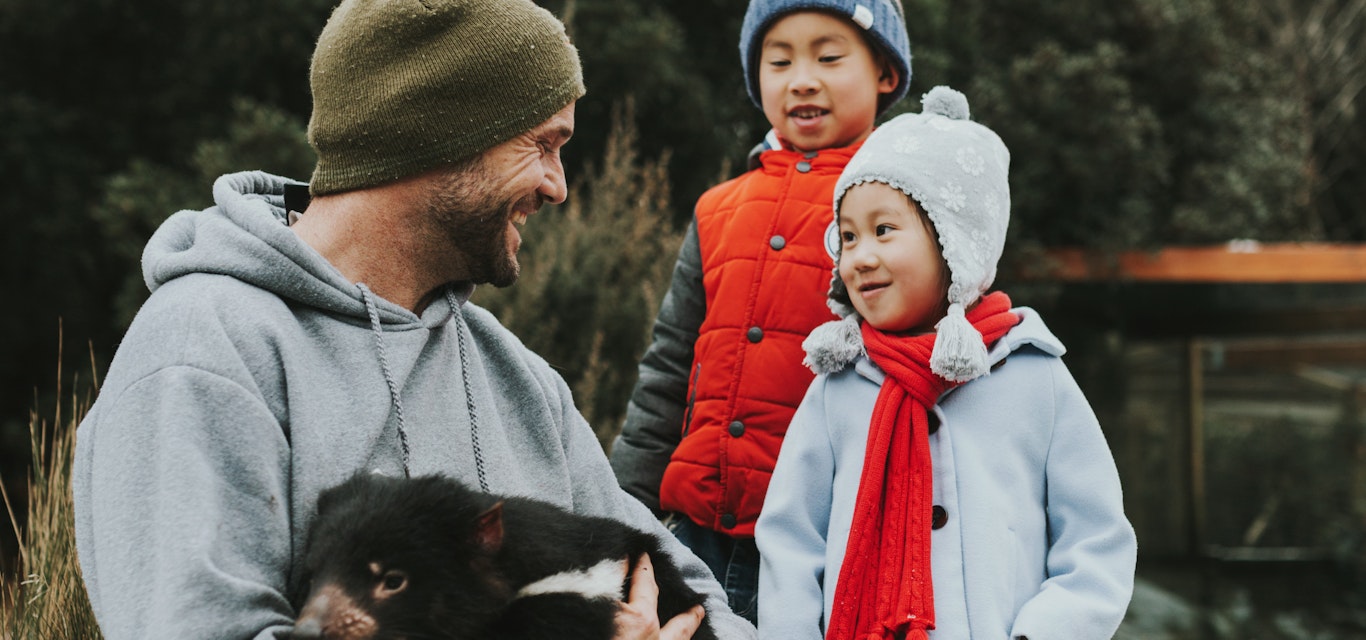Meet the locals
Spend any time in Tasmania and you will quickly see that the island state is teeming with wildlife. Some are relatively easy to find. Others are more difficult to locate, unless you know where to look.
Find the Tasmanian devil in Tarkine
Once found all over Australia, the Tasmanian devil is now restricted to its namesake state. Numbers have plummeted in recent years due to the impact of a facial tumour disease, landing these carnivorous marsupials on the endangered species list.
One of the best chances of seeing a wild Tasmanian devil is in the Tarkine region, the second-largest temperate rainforest in the world. Listen after dusk for the distinctive snarls and screeches as these scavengers squabble over food. It was this noise that earned them their name from early European colonialists. You can also get up close to a devil in the unique Devil Den at Unzoo on the Tasman Peninsula or watch all the action of feed time in the 360-degree viewing enclosure at Devils @ Cradle.
Credit: Rob Burnett
Uncover the Eastern quoll in Mt Field National Park
Like their cousins the devils, the eastern quoll once roamed on mainland Australia. The introduction foxes and cats quickly reduced their numbers and the last mainland sighting was in Sydney in the early 1960s. Now, wild populations occur only in Tasmania. Pack your torch and stay the night in Mt Field National Park for a good chance of seeing this nocturnal marsupial hunt for dinner. Feed a quoll yourself on a Night Tour at Bonorong Wildlife Sanctuary just outside Hobart. Or, tuck into your own four-course campfire dinner while the wildlife feed nearby on a Quoll Patrol Wildlife Tour.
Spot iconic parrots in the south-west
Need more convincing that Tasmania is a wildlife haven? There are only three species of migrating parrot in the world and two of them choose to breed solely in Tasmania. Unfortunately, both are critically endangered. There are fewer than 100 orange-bellied parrots remaining in the wild. They breed in south-west Tasmania every summer before making the dangerous journey across Bass Strait to their mainland wintering grounds. Join a Southwest Wilderness Experience with Par Avion for your best chance of seeing these rare birds in one of Tasmania’s most beautiful and remote regions.
Swift parrots, as the name suggests, are the world’s fastest parrots. After wintering on the Australian mainland they migrate to Tasmania to feed on the nectar of the flowering blue gum between September and March. A reliable place to see these colourful parrots is with Inala Nature Tours on Bruny Island, home to all of Tasmania’s 12 endemic birds.
Credit: Par Avion Wilderness Tours
Witness a wombat run
The relatively cooler temperatures in Tasmania make the state ideal for wombat-spotting. Unlike their mostly nocturnal mainland cousins, wombats in Tasmania can often be found out and about during the day foraging on grasses and shrubs. They must also chew on tough material like bark to wear down their incisor teeth which, like those of rodents, grow continuously. The teddy bear - like marsupial is known for its characteristic waddle but could pass an Olympic sprinter, running at up to 40km/hr. So if you see one, keep your distance and get that camera out before they disappear. Head to Maria Island, Mt William or Cradle Mountain– Lake St Clair National Parks and you’re almost guaranteed to see several of these endearing animals grazing in the sun (or snow!).
Credit: Frederic Courbet
Watch little penguins waddle
The world’s smallest penguin species, and the only one that breeds in Australia, lives around the coastline of Tasmania. After foraging at sea during the day, little penguin parents return to shore at dusk each evening, crossing the beach and approaching their burrows in small groups. This daily routine makes the little penguin perfect for bird watching. There are several sites in Tasmania where you can watch them come ashore without disturbing them. View the parade from boardwalks and elevated platforms at the Bruny Island Neck, join a guided Bicheno Penguin Tour or take a photo with the three-metre-high statue in the town of Penguin itself.
Credit: Dan Fellow
